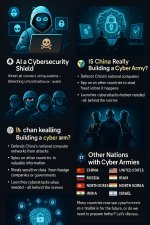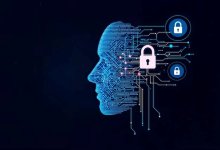:
As technology evolves, the digital world is becoming more advanced — but also more dangerous. The rise of Artificial Intelligence (AI) and the rapid growth of the internet have not only changed how we live and work, but also how crimes are committed. In this digital age, cybercrime (crimes committed using computers and networks) has become smarter, faster, and harder to detect. Let's explore how AI is both a threat and a solution in the fight against cybercrime.
In the past, most cyberattacks were carried out manually. But now, AI helps cybercriminals create highly advanced attacks that are difficult to identify and stop. One of the most concerning developments is the use of deepfakes — AI-generated fake videos or voice clips that look and sound real. These can be used to trick people into revealing confidential information or sending money.
Another rising threat is AI-powered phishing (sending fake messages to steal data). These attacks are no longer generic; they are highly personalized and designed to fool even tech-savvy users. Criminals use machine learning (a type of AI that learns from data) to study user behaviour and create fake emails that look completely real.
AI is also being used to break into systems faster. By scanning millions of files and network activities in seconds, AI can detect weak points and help hackers enter even the most secure systems.
Thankfully, AI is not only helping attackers — it’s also helping cybersecurity experts (people who protect systems and data) stop them. AI can monitor systems 24/7, detect unusual behavior, and alert users in real-time. It learns from past threats and adapts to new ones quickly, making it a powerful defense tool.
For example, banks use AI to track suspicious transactions and stop fraud before it happens. Antivirus software is now powered by AI to recognize and block new viruses automatically. AI can also help large companies protect their data by managing huge volumes of information that humans cannot handle alone.
The damage caused by AI-driven cybercrime is already being felt around the world. In some cases, hackers have used AI to trick employees into transferring large sums of money. In others, personal data of millions of users have been stolen and sold on the dark web. As AI tools become more accessible, even small-time criminals can launch powerful attacks.
Yes — and it’s not just a rumor! 
China is reportedly developing a powerful cyber army — a special team of skilled hackers and tech experts trained to protect their digital systems and launch cyber operations (online actions like spying or hacking). This is part of China’s bigger goal to become a global tech leader.
 What does this cyber army do?
What does this cyber army do?
 In today’s world, cyber power = real power — and it’s shaping the future of global security.
In today’s world, cyber power = real power — and it’s shaping the future of global security.
With the growth of AI and the internet, it’s becoming harder to know what’s real and what’s fake. This raises big questions:
The future of cybercrime is closely linked to the future of AI. As both continue to grow, we must learn to use technology responsibly and protect ourselves from its risks. AI is a powerful tool — it can either protect or attack, depending on who controls it.
To stay safe, we must stay informed, keep our software updated, use strong passwords, and be careful about what we share online. The digital world will keep changing, but with smart habits and the right knowledge, we can stay one step ahead.
What do you think about AI in cybercrime? Are we ready for the future, or do we need to prepare better? Let’s discuss.

 Cybercrime and AI: The Future of Digital Threats
Cybercrime and AI: The Future of Digital Threats
As technology evolves, the digital world is becoming more advanced — but also more dangerous. The rise of Artificial Intelligence (AI) and the rapid growth of the internet have not only changed how we live and work, but also how crimes are committed. In this digital age, cybercrime (crimes committed using computers and networks) has become smarter, faster, and harder to detect. Let's explore how AI is both a threat and a solution in the fight against cybercrime. AI in Cybercrime: Smarter Attacks Ahead
AI in Cybercrime: Smarter Attacks Ahead
In the past, most cyberattacks were carried out manually. But now, AI helps cybercriminals create highly advanced attacks that are difficult to identify and stop. One of the most concerning developments is the use of deepfakes — AI-generated fake videos or voice clips that look and sound real. These can be used to trick people into revealing confidential information or sending money.Another rising threat is AI-powered phishing (sending fake messages to steal data). These attacks are no longer generic; they are highly personalized and designed to fool even tech-savvy users. Criminals use machine learning (a type of AI that learns from data) to study user behaviour and create fake emails that look completely real.
AI is also being used to break into systems faster. By scanning millions of files and network activities in seconds, AI can detect weak points and help hackers enter even the most secure systems.
 AI as a Cybersecurity Shield
AI as a Cybersecurity Shield
Thankfully, AI is not only helping attackers — it’s also helping cybersecurity experts (people who protect systems and data) stop them. AI can monitor systems 24/7, detect unusual behavior, and alert users in real-time. It learns from past threats and adapts to new ones quickly, making it a powerful defense tool.For example, banks use AI to track suspicious transactions and stop fraud before it happens. Antivirus software is now powered by AI to recognize and block new viruses automatically. AI can also help large companies protect their data by managing huge volumes of information that humans cannot handle alone.
 Real-World Impact
Real-World Impact
The damage caused by AI-driven cybercrime is already being felt around the world. In some cases, hackers have used AI to trick employees into transferring large sums of money. In others, personal data of millions of users have been stolen and sold on the dark web. As AI tools become more accessible, even small-time criminals can launch powerful attacks. Is China Really Building a Cyber Army?
Is China Really Building a Cyber Army?
Yes — and it’s not just a rumor! China is reportedly developing a powerful cyber army — a special team of skilled hackers and tech experts trained to protect their digital systems and launch cyber operations (online actions like spying or hacking). This is part of China’s bigger goal to become a global tech leader.
 Defends China’s national computer networks from attacks
Defends China’s national computer networks from attacks Spies on other countries for valuable information
Spies on other countries for valuable information Steals sensitive data from foreign companies or governments
Steals sensitive data from foreign companies or governments Launches cyberattacks when needed — all behind the scenes
Launches cyberattacks when needed — all behind the scenes
 The Challenges Ahead
The Challenges Ahead
With the growth of AI and the internet, it’s becoming harder to know what’s real and what’s fake. This raises big questions:- How can we protect ourselves from deepfakes?
- Can AI systems ever become too powerful to control?
- How do we make sure our personal data stays safe?
 Other Nations with Cyber Armies
Other Nations with Cyber Armies
 CHINA
CHINA
- Unit 61398 and other groups operate under the PLA (People’s Liberation Army).
- Focuses on cyber espionage, data theft, and network infiltration.
- Believed to have one of the largest state-sponsored hacking forces.
 UNITED STATES
UNITED STATES
- U.S. Cyber Command (USCYBERCOM) is a dedicated cyber military wing.
- Protects national interests and carries out offensive cyber operations.
- Collaborates with NSA (National Security Agency) for intelligence.
 RUSSIA
RUSSIA
- Known for its sophisticated state-sponsored hacking groups like Fancy Bear and Cozy Bear.
- Uses cyber tools for influence operations, especially during elections and geopolitical conflicts.
 IRAN
IRAN
- Has developed advanced cyber units under its Islamic Revolutionary Guard Corps.
- Conducts cyberattacks targeting infrastructure and adversaries in the Middle East and beyond.
 NORTH KOREA
NORTH KOREA
- Operates elite hacker units like Lazarus Group.
- Involved in high-profile cyberattacks, ransomware campaigns, and cryptocurrency thefts.
 INDIA
INDIA
- Emerging player with increasing focus on cybersecurity.
- Working on a Defence Cyber Agency to strengthen cyber defense and offensive capabilities.
 ISRAEL
ISRAEL
- World leader in cyber defense.
- Unit 8200 is one of the most advanced cyber intelligence units globally.
- Famous for developing the Stuxnet virus (with U.S. cooperation) to disrupt Iran’s nuclear program.
 Conclusion: Stay Smart, Stay Safe
Conclusion: Stay Smart, Stay Safe
The future of cybercrime is closely linked to the future of AI. As both continue to grow, we must learn to use technology responsibly and protect ourselves from its risks. AI is a powerful tool — it can either protect or attack, depending on who controls it.To stay safe, we must stay informed, keep our software updated, use strong passwords, and be careful about what we share online. The digital world will keep changing, but with smart habits and the right knowledge, we can stay one step ahead.
What do you think about AI in cybercrime? Are we ready for the future, or do we need to prepare better? Let’s discuss.





